By Claire Marie Porter & Photography by Rob Cordillo
On the 50th anniversary of Earth Day, Grid is celebrating trees: their resilience, beauty and spirit, and their fortitude amidst an ever-changing climate and ecosystem.
When I reflect on the life of a tree, I can’t help but think about Shel Silverstein’s The Giving Tree, a children’s picture book about a tree that loved a little boy so much, she gave him everything he asked for, until she had nothing left to give. Even in death, trees give us life. Trees are our heroes. They clean and condition the air, produce oxygen, and reduce stress and noise pollution. Trees also manage stormwater and sequester carbon, while providing spaces for children to play and habitats for countless species of insects, animals and fungi. And those are just their passive benefits, not to mention how much we rely on wood in our daily lives. They give and give and give.
“Trees are like people,” says Scott Wade, a Longwood Gardens arborist and curator of Peirce’s Park, one of Longwood’s oldest sections, which houses a historic tree collection. He also leads the Pennsylvania Champion Tree Program, established by the Pennsylvania Forestry Association, which catalogs the biggest and oldest trees in the state. Champion trees are nominated and ranked using a point system to measure circumference, height and canopy spread. “There are a bunch of natural threats that can take a tree down,” he says, and in Pennsylvania, there’s little protection for trees on private property.
Pennsylvania, Latin for Penn’s Woods, was once covered in forests of old-growth trees. When the timber industry took off in the 1800s, trees were almost completely wiped out across the state. “Back then, to find a tree of any size was rare,” says Wade, “because of clear-cutting, the state was denuded by 1900.” The only places with trees were private properties, usually people’s estates. “You could see the horizon,” says Wade, speaking of pictures taken at the time. “There were no trees.”
When programs like the champion tree program, which has been cataloging big trees for over 50 years, and others started bringing awareness to the importance of trees, foresters began competing to find the biggest ones, says Wade.
“Most of these primeval forests have been cut down for agriculture, and our woods now are mostly second-growth, with few big trees in them,” explains Aaron Greenberg, arboretum manager at Laurel Hill Cemetery, and new coordinator for the champion tree program.
The most recent nomination for a champion tree is a towering sycamore on the private property of a West Chester family. Others include a white oak behind the London Grove Friends Meetinghouse, and the Lansdowne Sycamore, a longstanding champion tree.
According to Wade, many of the trees left behind are sycamores, because they aren’t really good for anything but shade. Historically, sycamores were planted at the southwest corner of properties for shade.
“They would use the tree to shade all summer,” says Wade, “and then it would drop its leaves and let the sun through for winter.”
Many champion trees are misshapen because straight trees are preferred over crooked ones for timber. Trees that are likely to have been around since William Penn founded Pennsylvania in 1682 are called “Penn Trees.” “These were recorded first in 1932 in honor of the 250th anniversary of Penn’s arrival, and a few are still around today,” says Greenberg. “Large trees are very important for our state heritage and our understanding of nature. These trees tell stories about the history of Pennsylvania.”
And the ecological gains of big trees are also vast, as their benefits increase with their size and age, he points out. Big trees have up to 200 times the ecological value of small ones, so planting a small tree to replace an old one is not an even swap, says Greenberg. “By recording them, we hope to inspire people to visit and protect these incredible resources,” he says.
Unchecked development and deferred maintenance are the two biggest threats facing big trees in Philadelphia, he believes. “People need to see the value in our urban forest. The benefits large trees provide are tangible and quantifiable, from energy savings provided by shade to increased quality of life,” Greenberg says.
While trees don’t need people to survive, people do need trees. Research has shown this empirically, which is why there’s been such a push for urban forestry in recent years. The distinction between forests and urban forestry is the human interaction component—trees and people have to learn to co-mingle and live together in a city, unlike the natural and serene environment of forests, where trees are left alone.
Without trees our Earth would lack essential functions for human survival. In terms of physical benefits, trees are incredibly efficient carbon offsets, sequestering carbon and accumulating it in the form of biomass, deadwood and soil. In 2017 alone, trees in the U.S. absorbed enough CO2 to offset more than 11 percent of America’s emissions that year. They also prevent areas of the city from becoming “heat islands” by lowering surface and air temperatures.
Planting trees, especially in urban areas, has been proven to have numerous ecological, physical and even social effects on well-being. The psychological impacts are also huge. In Japan, the act of taking in nature through a walk in the woods is called shinrin-yoku, which translates as “forest bathing.” It doesn’t require a forest, just a nearness to nature.
A champion American elm stands tall at Scott Arboretum, Swarthmore.
Philadelphia, “America’s Garden Capital,” with 300 years of horticulture under its belt, offers abundant ways to get near nature: there are the great big trees at Morris Arboretum and Tyler Arboretum, the horticultural feast of Laurel Hill Cemetery, the grounds and greenhouse of Fairmount Park Horticultural Center, the Woodlands sprawl of more than 1,000 trees.
There was a time not too long ago when the United States was still covered in trees. Prior to European settlement, it’s approximated that 46 percent of the U.S. was forested. By 1907 it was reduced to 37 percent, and trees were not being planted to replace those being cut down. Increased reforestation efforts in the 20th century by organizations like the U.S. Forest Service and Arbor Day Foundation have reversed that trend so that there are now more trees being planted than being cut down in the U.S. But according to the World Economic Forum, “man-made forests do not compensate for the damage and degradation done to ecosystems through land clearance.” And most of these forests are second-growth, meaning most old trees are long gone. “Philadelphia’s tree canopy has decreased by 6 percent between 2008 and 2018,” says Erica Smith Fichman, Community Forestry Manager at Philadelphia Parks & Recreation and leader of the TreePhilly program.
“While pockets of the city have seen improved canopy in this time, overall we have lost trees, especially on residential land and along streets,” says Smith Fichman.
TreePhilly, a partnership between Philadelphia Parks and Recreation, Fairmount Park Conservancy and TD Bank, has given away 24,000 yard trees since 2012.
Another part of the TreePhilly mission is to help residents better understand the value of trees in their neighborhood through public education and awareness, says Maita Soukup, Philadelphia Parks and Recreation associate director of communications.
“As a city, we are on the frontline of the impacts of climate change, like flooding, extreme weather and drought. Trees play a critical role in our city’s infrastructure, and our ability to remain sustainable and resilient in the face of a changing climate,” says Smith Fichman.
The major urban forests, Pennypack, the Wissahickon, Fairmount parks, combined with yard and street trees all constitute the “tree canopy.”
“East and West Fairmount Parks were initially developed by the city to protect Philadelphia’s public water supply and preserve quality of life during the industrial revolution,” says Smith Fichman. Trees are essential to the health of the city and well-being of its inhabitants, she says. “Shifting attitudes about trees in our city also takes time,” says Smith Fichman, “but this hard work needs to be done, and it will ultimately lead to the change that allows our canopy to flourish into the future.”
The Fairmount Park Conservancy, a nonprofit organization that evolved out of Philadelphia’s Fairmount Park Commission, has been working on reforestation of Philadelphia’s parks for the past two years. Executive director Maura McCarthy says this reforestation project is “our first foray into urban forestry.” This past December it planted 5,000 trees and shrubs on a 30-acre parcel of land in West Fairmount Park near the Montgomery and Lansdowne creeks, in an effort to revitalize land that had been denuded by invasive, non-native species of plants and vines that lack ecological value to native animals and migratory birds.
That, combined with the abundance of white-tailed deer, and Philadelphia dumping, says McCarthy, have made the cleaning and clearing process step No. 1.
“All that earth is then upheaved,” she says. “We have to try and restore the biomass to the area.” The area is being reforested with natives species, such as juneberries, willows, beech, ironwood and holly—all critical plants and trees that support insect and small mammal populations, as well as migratory birds. “We’re also planting good old oaks that support more insect species than any other trees,” she says, adding that the white oaks, “the beauty queens of the forest,” draw all kinds of small critters.
Hopefully, we’ll start to see populations of the animals that are most closely associated with those native species: hummingbirds where there’s jewelweed, goldfinches where there’s sweet gum, and foxes where there’s black cherry, she says. “Any organization looking at improving lifestyle conditions in a city is sort of grappling with the balance of open space and green space and its accessibility to the public,” McCarthy continues.
The city is recognizing the ecological utility and health benefits that come with trees, especially in dense urban conditions. “There’s this false dichotomy where people think ecological issues are separate from human issues,” she says. “It’s all one issue.” The Fairmount program is focused on “the person side of the equation,” says McCarthy, because people are both the biggest threat and biggest promise when it comes to the life of the forests. “When you’re doing environmental restoration work,” says McCarthy, “you’re actually doing public service work and public health work.” “Helping Philadelphians re-see our forest is a really important job,” she says.
Richard Powers writes in his novel The Overstory, which addresses mankind’s destruction of forests: “This is not our world with trees in it. It’s a world of trees, where humans have just arrived.” The scientific consensus is that trees have been around for about 370 million years. So in tree terms, homosapiens, at just 200,000 years old, are a new and invasive house guest. Yet we have historically seen trees only for what they can do for us, often regarding them with a vague romance, especially the big ones.
Karen Flick, the landscape manager at Awbury Arboretum, says we need to change our perspective, and realize that “we are in a forest.” “There is nature all around us,” she says. But, the tendency is to not really see or care about trees until we miss them, she adds. And we’re only recently understanding the empirical evidence about the impact that trees have on people. “The benefit that trees have on people, on our emotional, physical health, is just huge,” she says.
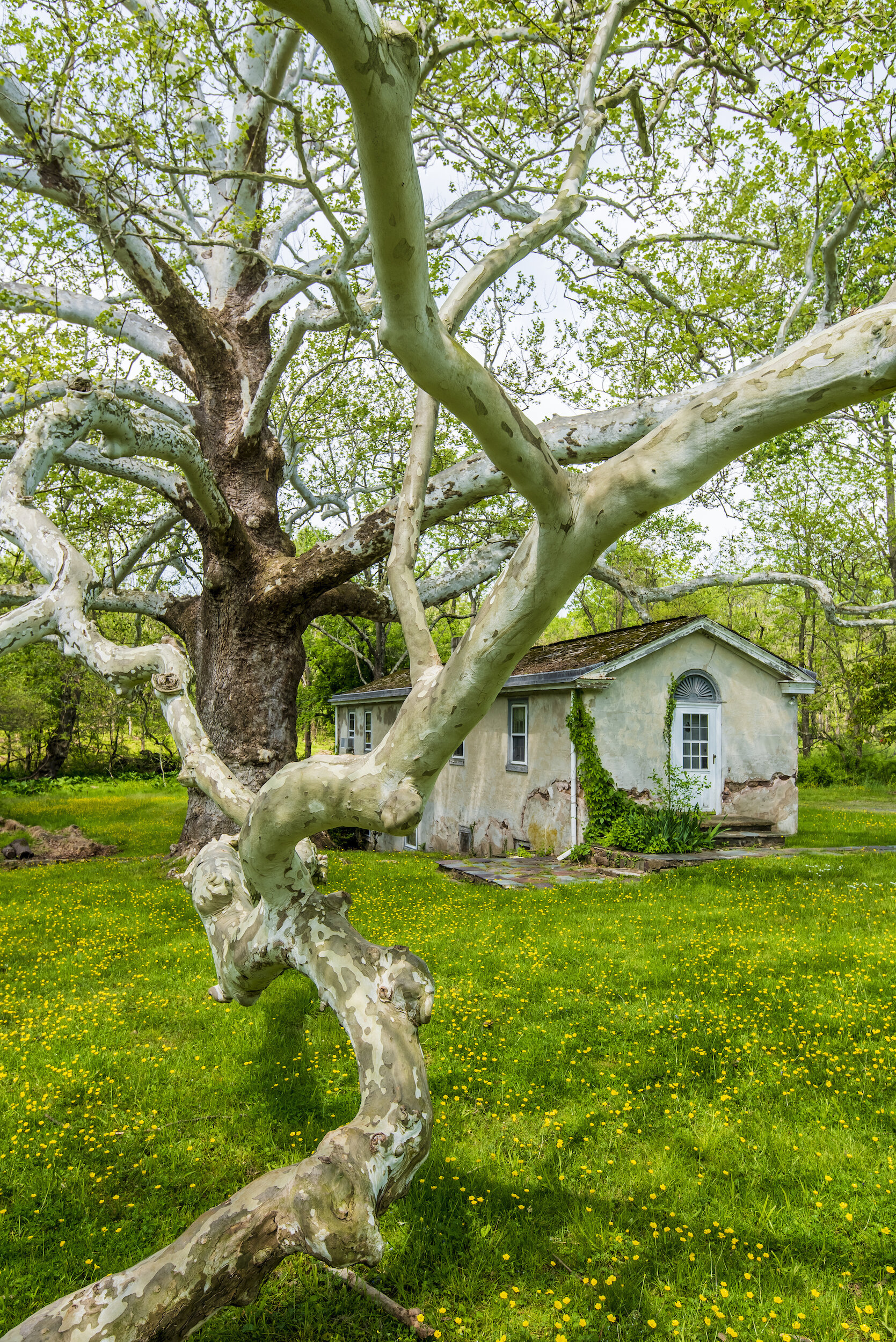
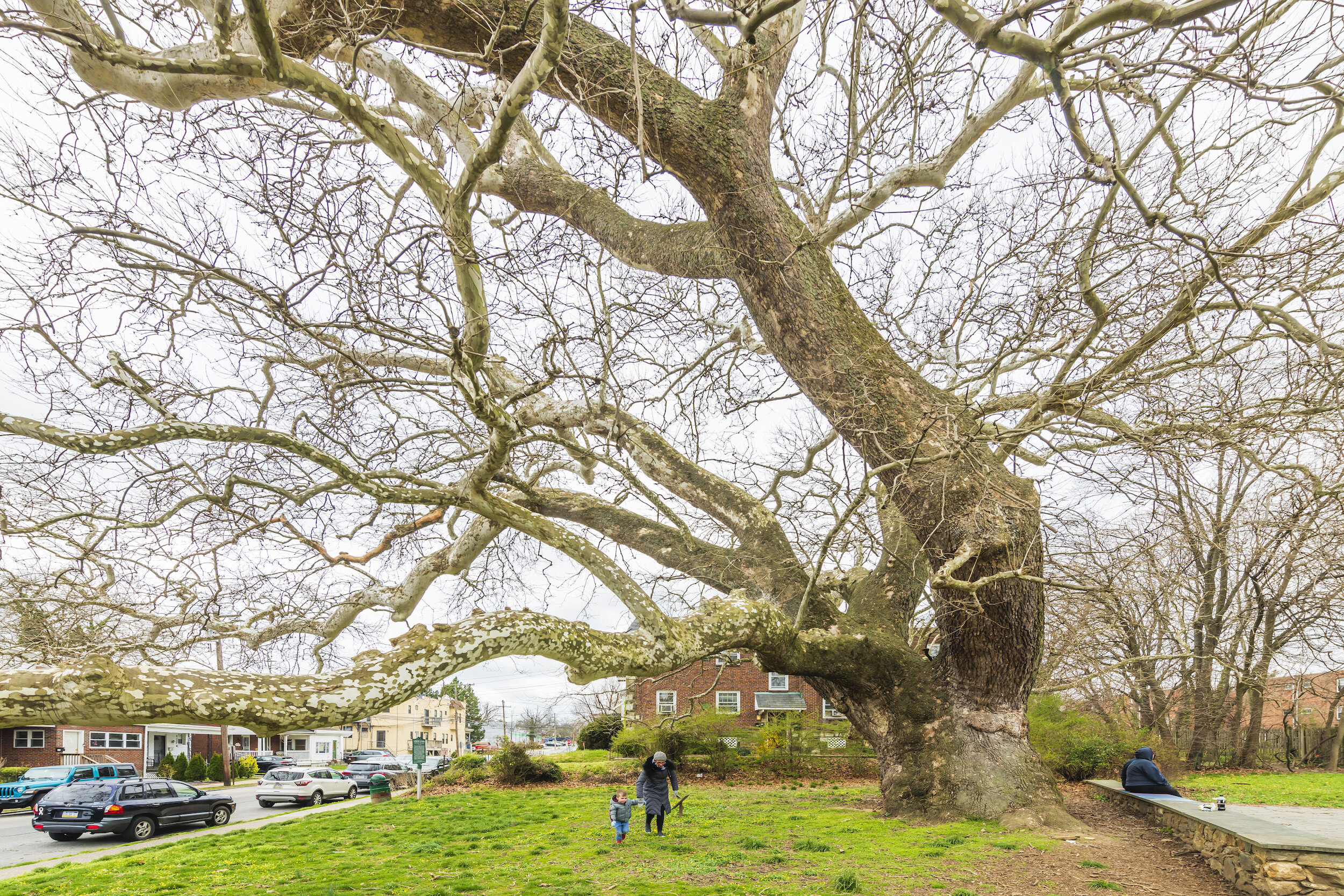

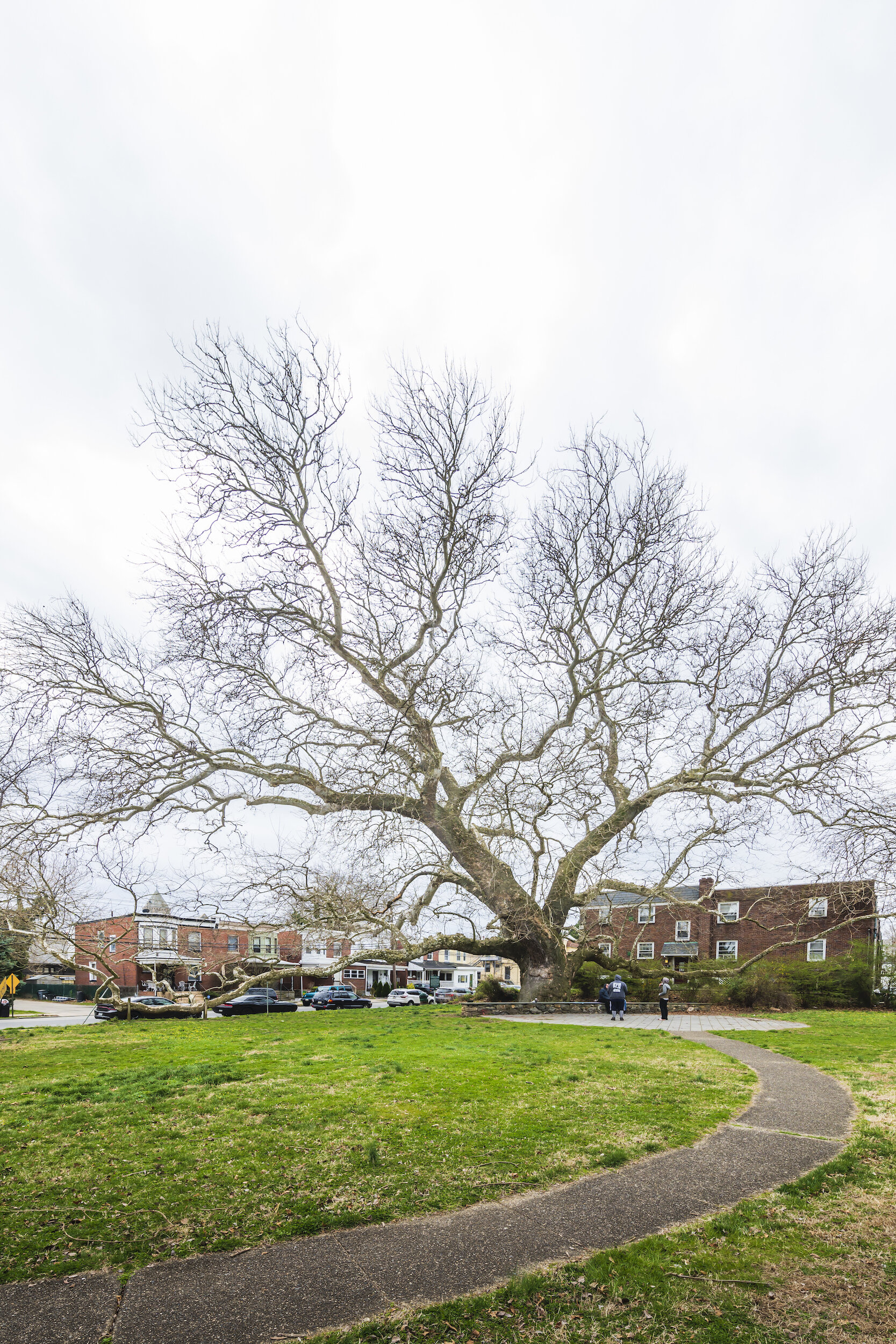
A 2015 study from the Centre for Research in Environmental Epidemiology in Barcelona found that the more greenery children are exposed to, the better their attention skills and memory development. The “biophilia hypothesis,” proposed by Yale ecology professor and evolutionary biologist Edward O. Wilson, suggests that humans have an innate desire for nature, and that loss of it would have significant detrimental effects on our mental health.
A 2019 study by University of Wollongong showed that adults in neighborhoods that enjoyed a 30 percent or more tree canopy were 31 percent less susceptible to psychological distress, and had 33 percent lower odds of rating their general health as less than “good” over a six-year period.
We are in a process of learning from past mistakes when it comes to forestry, says Flick. Planting polycultures to strengthen trees against diseases and pests is a part of that. “A diverse amount of trees is really important,” she says, “to avoid the pathogens that can wipe out a monoculture, [but also] creating a habitat for the good guys and inviting in a greater amount of wildlife and more diversity of predators.”
We’re starting to see a lot of different varieties of trees with a push toward tree diversity, she adds. A typical Philly street canopy will have London plane trees, a sycamore hybrid, and red maples, but now we’re starting to see a different variety of maples, even some non-native, and more oaks, especially willow oaks. There’s more variety in the understory as well, she says. Flick points out that lack of forethought with tree planting is why we see so many trees on city streets with a V-shaped cut-out to make space for the power lines. This is damaging to the tree, she says, and should be considered when planting.
The Awbury Arboretum has 60 heritage trees highlighted on the grounds, for the purpose of education. It helps out local tree tender groups, teaching people how to care for their trees, and making tree care accessible to the average person. But most importantly, her work focuses on teaching people to see trees.
Trees are like people in that they need community, she says. They’ll even reach out to each other under the ground through their roots, passing chemicals and nutrients back and forth, sometimes connecting to each other. A tree in a community is going to be much healthier than a tree in isolation. It will grow to its greatest potential, she says. “A tree will struggle by itself,” Flick explains. “Everything is a part of the trees’ community—the air quality, soil, wildlife and the people.” “I like to encourage people to pick a tree and visit it regularly and see how much more you start to see,” she says. Flick is partial to oak trees. “They have an old soul to them,” she says. “Even when they’re young, they have an old soul.”
Understanding and caring for trees means thinking in future terms. When planting a tree, we need to remember that it will likely outlive us, and even our children. It will be up against a very different climate, one that is warmer, windier and wetter. We can’t just plant any tree, anywhere. Urban environments are not really places where trees want to be naturally, says Jason Lubar, associate director of urban forestry at the Morris Arboretum. But he acknowledges the countless benefits of having them in the city. “The human spirit is lifted when there are trees in the city,” he says. “They improve neighborhoods.”
There are several tree species that can handle urban situations better than others, he says, particularly floodplain trees like London planes and pin oaks, ones that have adapted to compacted soil conditions and less oxygen to their roots. He agrees that species diversity is key, in large scales and on every street. He says that what we’ve learned from invasive pests like the spotted lanternfly, Asian longhorn beetle and hemlock woolly adelgid, and diseases like Dutch elm and chestnut blight, is that planting a diversity of species enhances resiliency of our urban forests from these pests and other stressors. “Realistically we cannot stop pests from entering North America,” he says. “Roughly every 10 years, a new potentially potent pest or disease is introduced to our environment.”
And we should anticipate more with a changing climate, he adds. We will lose some of our species locally, but may gain some new ones. Arboreta are experimenting with southernly adapted trees in anticipation of a warmer climate. Morris Arboretum collected southern live oaks from their northern-most occurrence in their natural range and are planting them in various urban and suburban environments, to see how they fare.
The compelling current narrative in arboriculture is that trees are an investment, Lubar says. “Unlike gray infrastructure, which degrades and depreciates,” he says, “trees appreciate and gain value with time.” “People need to get out more into nature and get amongst the trees. Trees are an important part of green infrastructure and enhance your well-being,” he says.
Recently, a friend told me that fallen hemlocks create a prime ecosystem for reishi mushrooms, an immune-boosting super fungus. The Atlantic published an article about the “undead” tree stump and how it finds life underground by connecting its roots with other trees. German forester Peter Wohlleben, author of The Hidden Life of Trees: What They Feel, How They Communicate—Discoveries From a Secret World, has shown evidence that trees have alliances, and will share sunlight and nutrients with each other, using pheromones to communicate—and really bonded ones might die in tandem with each other.
The Continental Army arrived at Valley Forge in December 1777 with 12,000 soldiers and wasted no time in felling hundreds of trees for firewood and other supplies, and to build huts and defense shelters.
Few trees were spared. Among those that were was a huge, crooked and bowing sycamore with limbs that reach almost to the ground. It’s located on the southwest corner of a 1700s springhouse on the grounds of what became Valley Forge Park. It’s called the Pawling Sycamore, named for the former estate on which it stands. It’s 22 feet in circumference and presumed to be between 260 and 285 years old.
Jackie Salmon greets the Lansdowne Sycamore.
The Pawling Sycamore is considered a “witness tree”—an expression used to describe trees that were present at key events in American history, often traumatic events. Witness trees have been known to grow new layers of bark to hide bullets buried in their trunks, adapting to their wounds, and healing their scars over time. During our current global pandemic, they, like the Giving Tree, are a constant reminder that there is life within death.
McCarthy encourages every Philadelphian to celebrate the 50th anniversary of Earth Day by connecting with whatever green space is right next to them. During this time of fear and uncertainty, we’re going to have to do without much contact or social gatherings.
“But the parks are there without mediation—the trees are safe,” she says “Find your nearest tree,” she says. “Hug it. Take care of it. Our parks can be a real place of respite.”



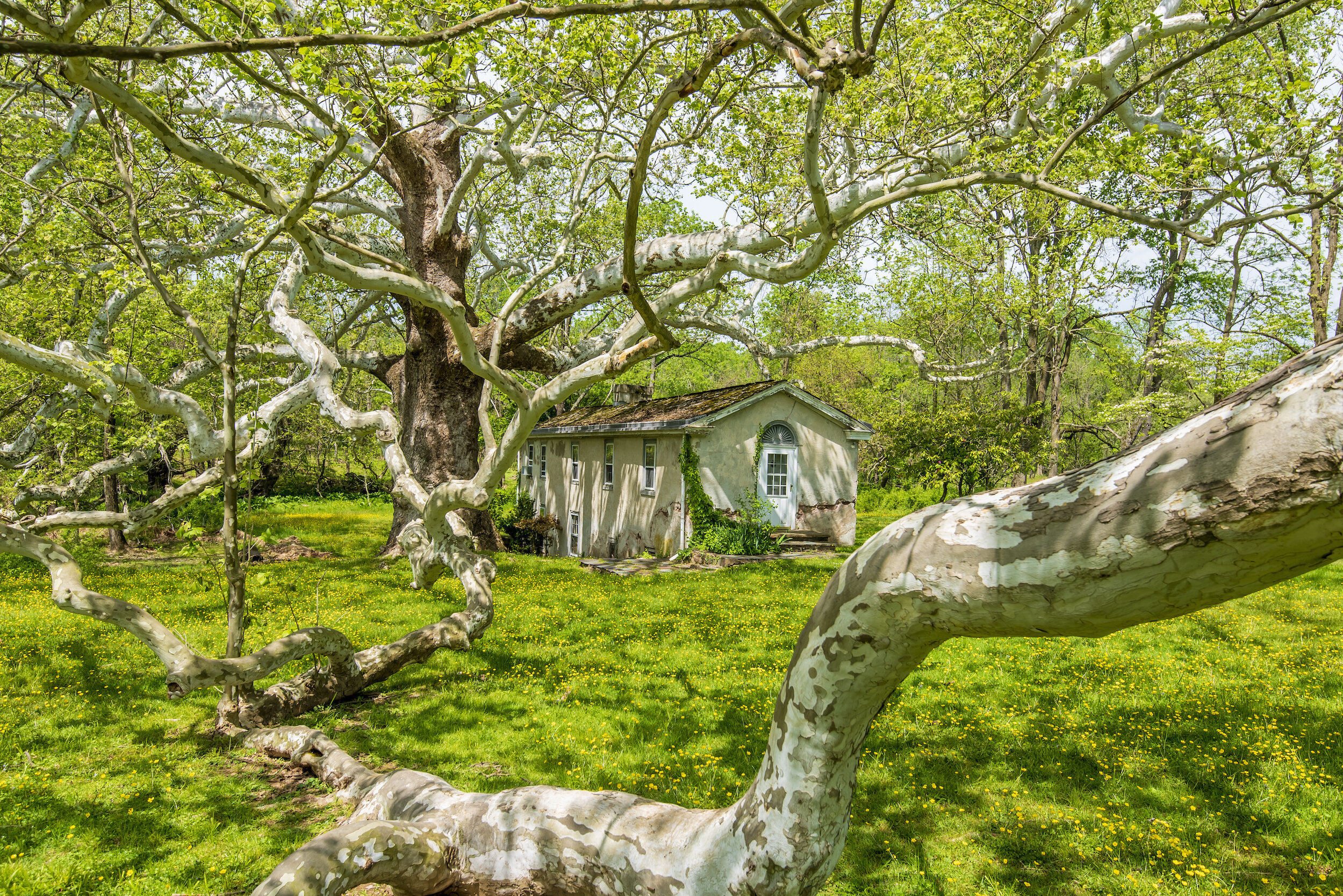
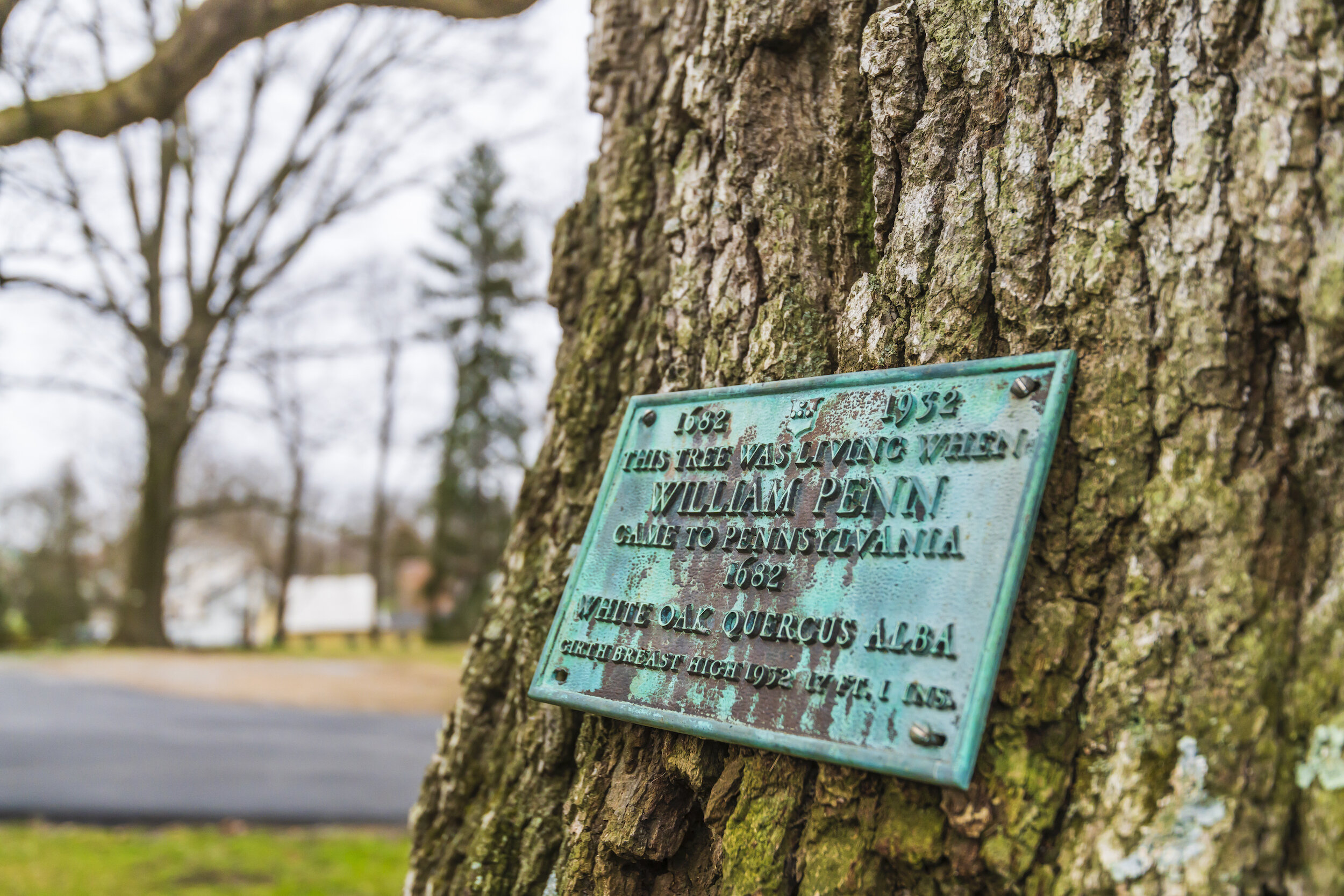
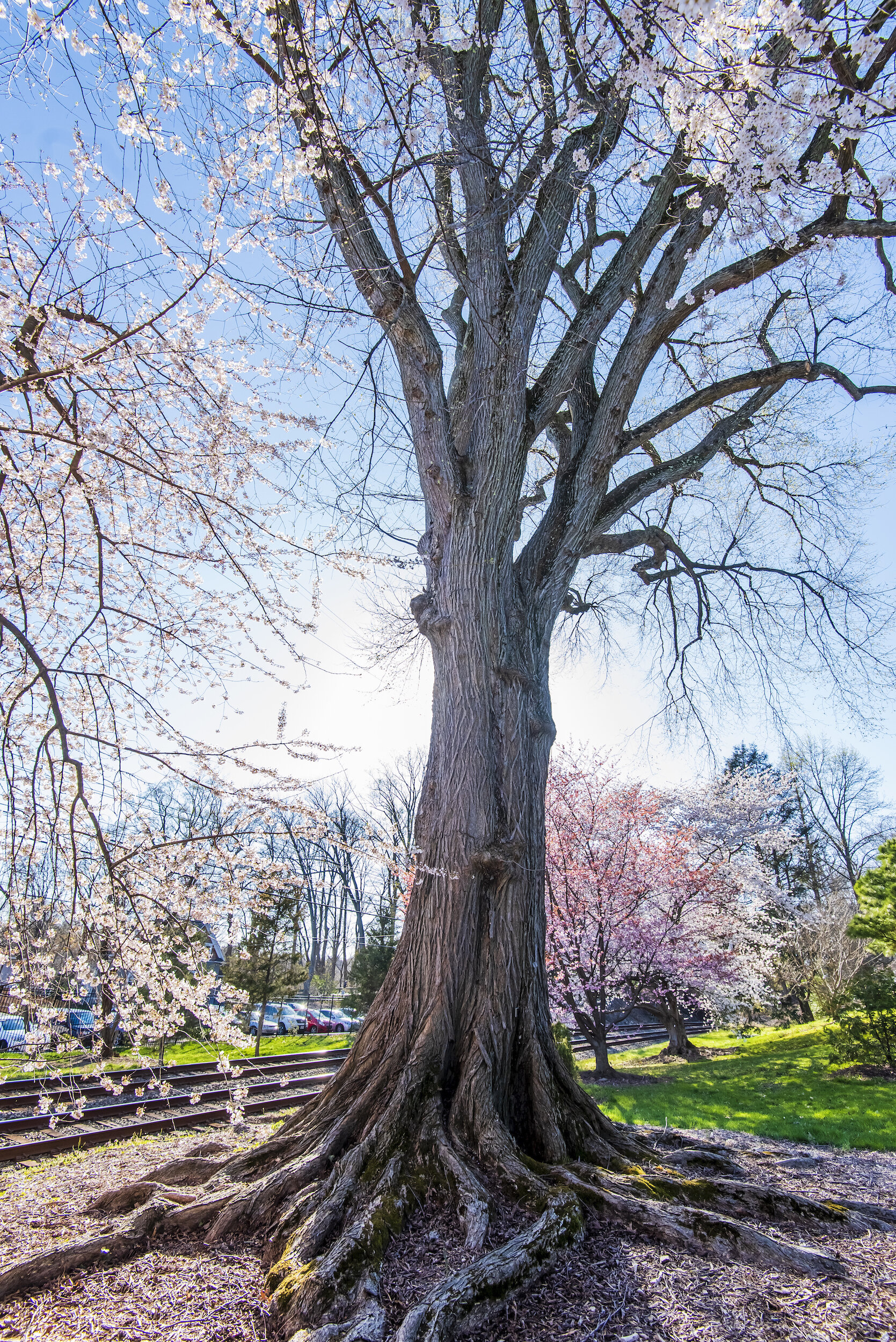
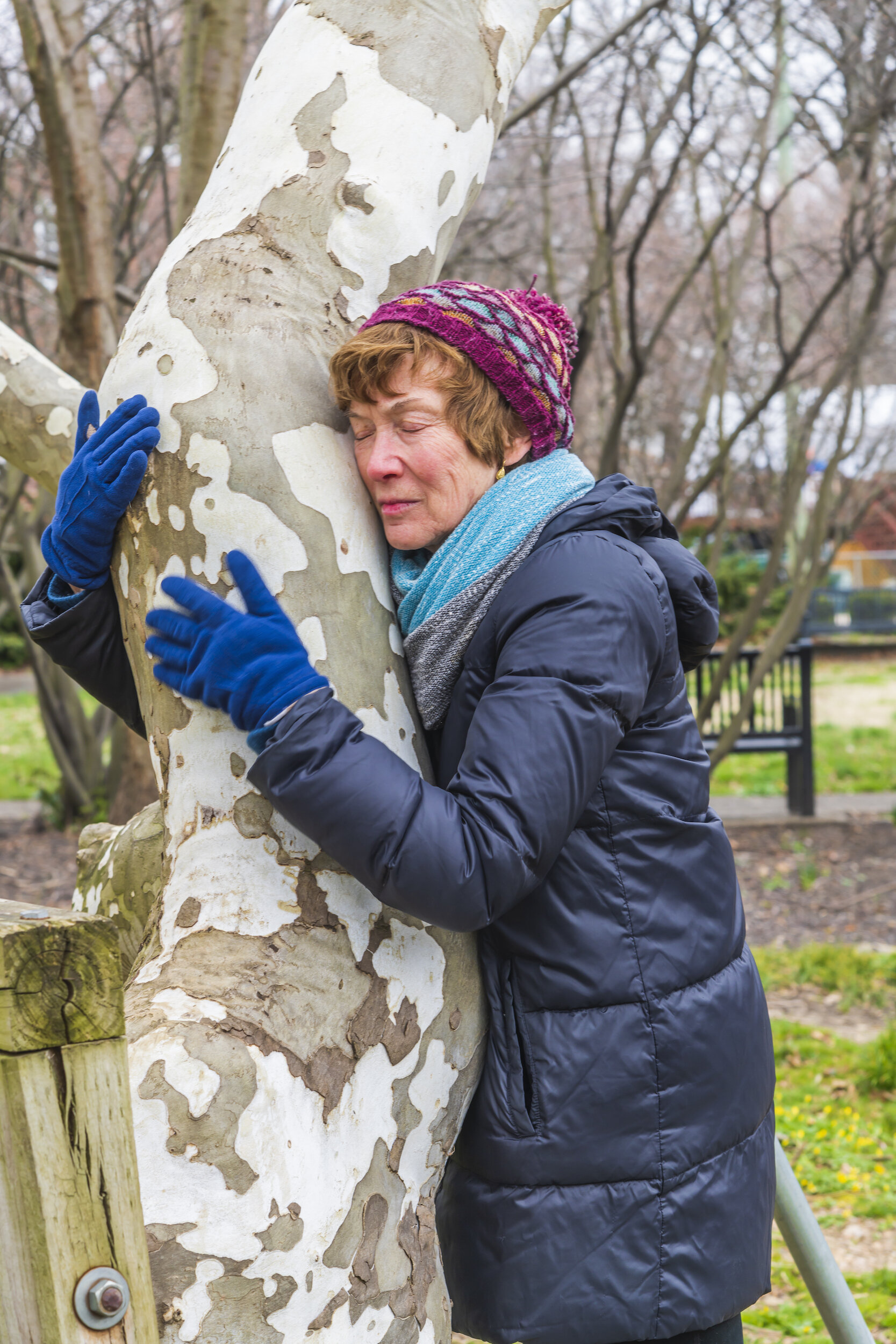

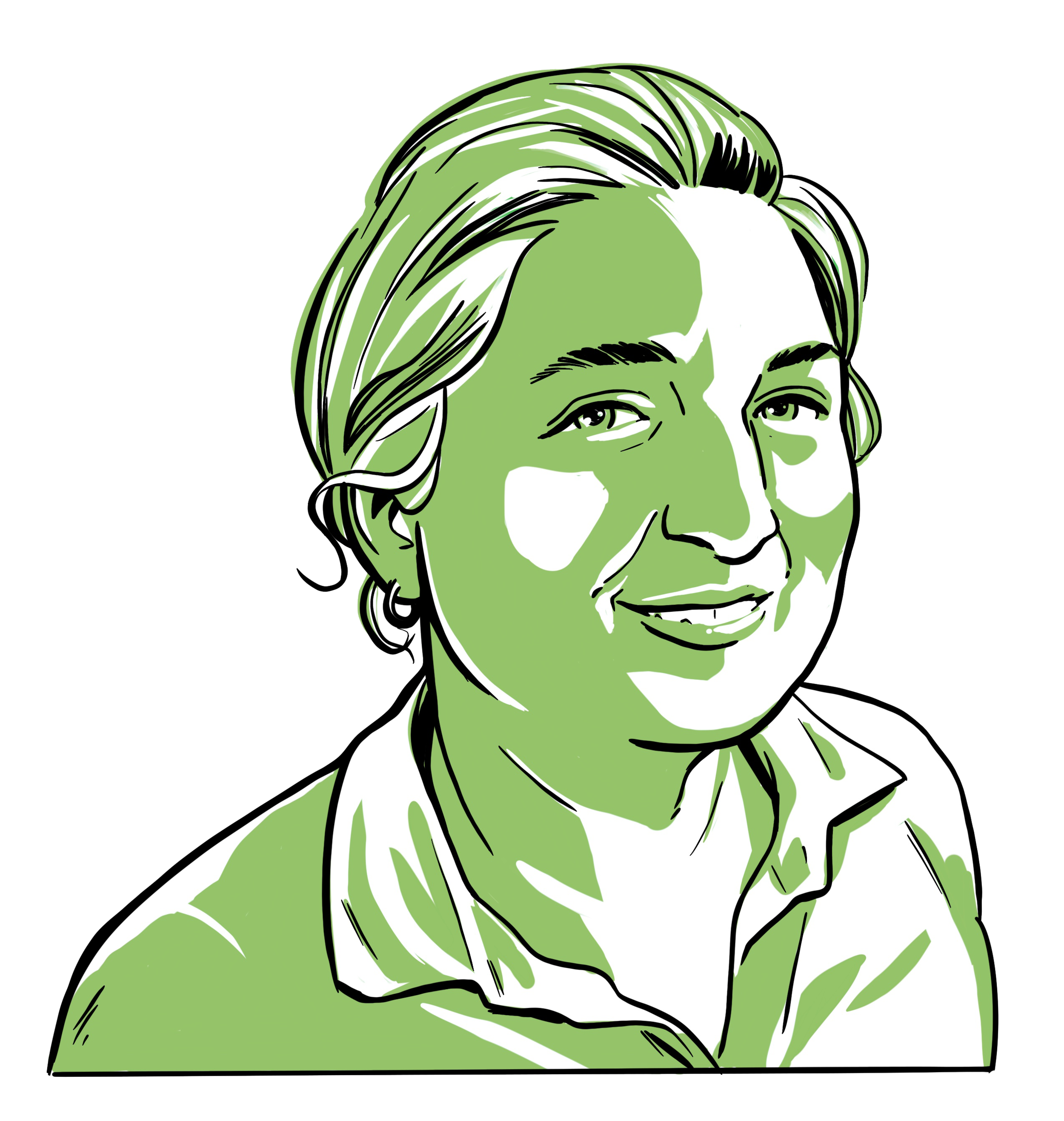





Wonderful article! One thing that could have been added was a bit about Carpenter’s Woods, which was dedicated in June 2018 into the Old-Growth Forest Network (www.oldgrowthforest.net) – a national network committed to the protection of old-growth trees as a vital part of our ecosystem. Many of Carpenter’s Woods’ trees are over 200 years old, with several approaching 250. Its truly unusual concentration of ancient trees – including black, red and white oaks, American beech, tulip poplar, black tupelo and American elm – allows Carpenter’s Woods, declared Philadelphia’s first bird sanctuary in 1921, to continue to host diverse species of both breeding birds and migrants. Thanks again for this great piece on the importance of our native trees.
Anne Bekker, Philadelphia County Coordinator, Old-Growth Forest Network